How and with what to eat turnips, and what does it taste and smell like?
Turnip cultivation began about 40 centuries ago. In Ancient Greece and Egypt, it was consumed only by the lower classes, and the upper classes considered it coarse food. The culture was the food of common people for quite a long time, but in the Middle Ages the baked root vegetable became a delicacy. Nowadays, a huge number of dishes are prepared from turnips, which are served in the best restaurants in the world.
What does turnip taste and smell like?
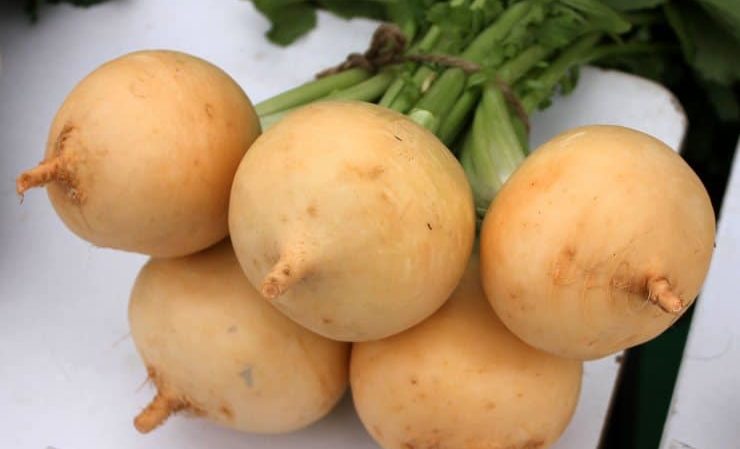
A high-quality root vegetable has a pleasant sweetish taste, as it contains up to 9% sugar. Pulp structure resembles white radish or firm radish. All these vegetables belong to the Brassica family.
Many people are interested in the question - what does turnip taste like? Turnips are not as tart as radishes; they have a softer and more pleasant taste, although a little specific. If you try a quality vegetable at least once, you won’t confuse it with anything else.
The smell of the raw root vegetable is reminiscent of the smell of radishes, while the cooked vegetable has a milder smell. Some people don’t like the aroma: this is due to the fact that the vegetable contains mustard oils, which impart bitterness.
What do you eat it with?
turnip consumed both raw and cooked. It is combined with other vegetables, meat, fish, mushrooms and dairy products. For this reason, the root vegetable is considered universal.
If someone doesn’t particularly like specific taste qualities, they are complemented with fresh herbs. Celery, arugula, lettuce, onions, parsley, cilantro and dill are suitable for this.
Use in cooking
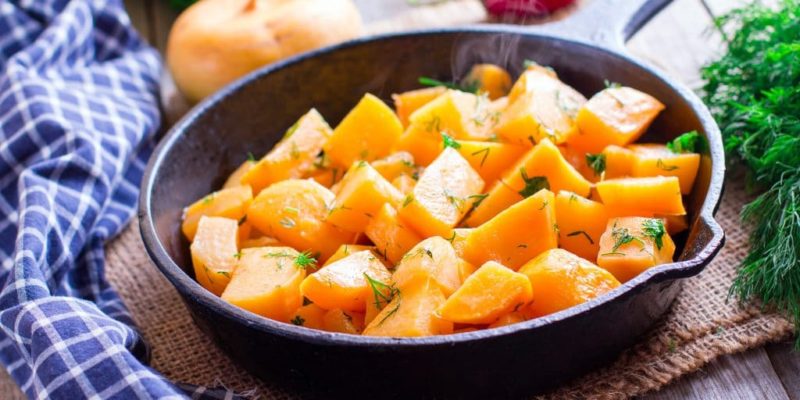
Turnip lovers eat it raw.It completely preserves nutrients and unique taste.
From a root vegetable prepare various salads. It goes well with any type of cabbage, radishes, radishes, cucumbers, corn, peas, beets, and tomatoes. Such salads are seasoned with sour cream or unrefined vegetable oil.
There are many recipes for sweet salads with turnips. They are made from pineapples, apricots, apples, pears, citrus fruits, pumpkins, etc. Whipped cream or heavy sour cream is used as a dressing. Instead of dairy products, whipped banana pulp is suitable.
Interesting! The boiled root vegetable is used to make desserts. It is crushed and added to muffins, puddings, and pies. The dehydrator makes crispy and healthy chips.
Turnips are added to vegetable soups and stews, baked in the oven as a separate dish or with other vegetables, steamed, and stewed.
Is it possible to eat turnips raw?
This root vegetable is consumed not only cooked, but also raw. Juices and vitamin salads are made from it.
The vegetable has analgesic and anti-inflammatory effects. Rich in succinic acid, which improves metabolism and prevents hypoxia.
The root vegetable has been used for many centuries along with cereals and bread. It was a staple in most European countries.
In its raw form, the vegetable dissolves uric acid, strengthens nails and hair, stimulates cardiac activity, and improves intestinal motility. It contains vitamins C, B1, B2, PP, A, so it is used to prevent vitamin deficiency.
Advantages and disadvantages of this use
Turnips contain glucoraphanin, which is responsible for regulating blood glucose levels and reduces the likelihood of cancer.
The raw vegetable contains beta-carotene, magnesium, potassium, sodium and sulfur. Sulfur helps cleanse the blood and break down kidney stones. Thanks to magnesium, calcium is absorbed in the required quantities. This makes bones stronger and more elastic.
Important! The large amount of ascorbic acid contained helps strengthen the immune system. It is recommended to eat turnips raw for colds.
The root vegetable has a positive effect on men's health. Succinic acid helps restore potency by normalizing blood circulation. The substance stimulates the body's adaptive capabilities, increases performance, improves memory and concentration.
In some cases, turnips can cause harm to the body. The essential oils in it irritate the intestinal mucosa; the vegetable stimulates the secretion of gastric juice. Therefore, raw turnips are contraindicated for people with stomach and duodenal ulcers. It should also not be used by patients with diseases of the central nervous system, food allergies, kidney and liver disorders.
It is important for people with thyroid diseases and diabetes to follow the normal consumption of this vegetable, giving preference only to unsweetened varieties.
How to properly eat turnips raw
The root vegetable should not be overused. The daily norm for an adult is 200–300 g. Regularly exceeding this limit can be harmful to health.
How to peel turnips
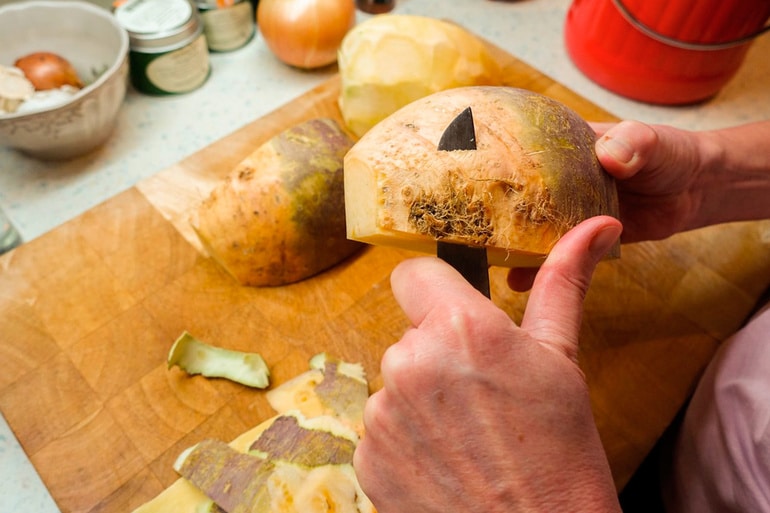
Turnips cut off the tail to the base. It is inedible because it is woody. Remove the top rosette of leaves. After this, peel the skin, like potatoes.
Methods for preparing turnips
The vegetable is baked, steamed, boiled, etc. Below are several recipes for dishes with root vegetables.
Stuffed turnips
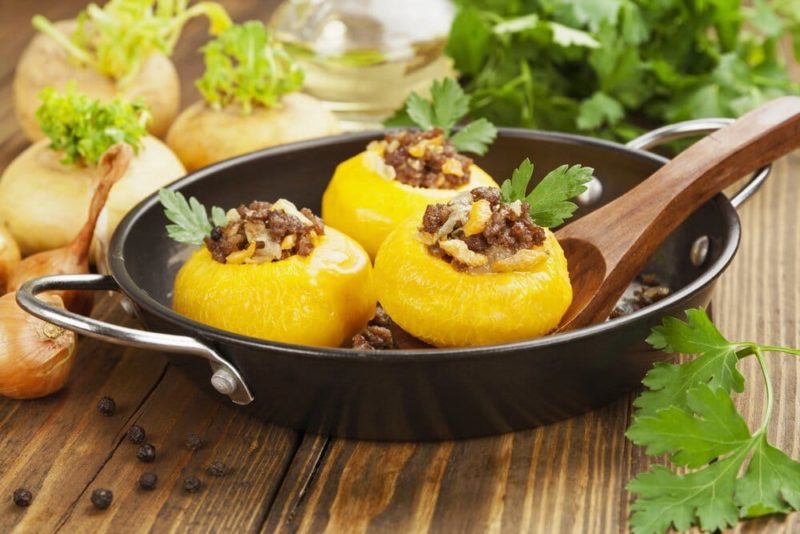
It will take 50–60 minutes to prepare the dish. You will need the following ingredients:
- large turnip - 1 pc.;
- eggs – 4 pcs.;
- fresh champignons - 300 g;
- medium-sized onion - 1 pc.;
- olive oil - to taste;
- butter - 10 g;
- sour cream - 2 tbsp. l.;
- turmeric - 1 medium pinch;
- cilantro - a small bunch;
- fresh thyme - 2 sprigs;
- salt and pepper - to taste.
Cooking method:
- Turnips are used as utensils, so they form a stable bottom and cut off the lid. The vegetable is carefully peeled. It is important that it does not roll around on the baking sheet while baking.
- Boil water in a saucepan, add salt and add thyme. Place the prepared turnips in a saucepan so that they are completely submerged in water. Cook over low heat for about 10 minutes to soften the root vegetable. Proceed to preparing the filling.
- Boil 3 eggs, peel and cut into cubes, as for a salad.
- Chop the cilantro as finely as possible.
- Chop the onion.
- The stems of the champignons are removed: they will not be used. The hats are cleaned and cut into large pieces.
- Mushrooms and onions are fried, salted and black pepper is added to taste. At the end of cooking, add butter and remove the pan from the heat.
- Place chopped greens, eggs, fried mushrooms and onions in a bowl. Add a pinch of turmeric and 1 tbsp. l. sour cream. Mix everything thoroughly. If necessary, add salt and pepper.
- Remove the turnips from the pan and place them in cool water to cool. The middle is taken out of it to make a baking pot.
- The roasting pan is covered with parchment and a turnip pot is placed on it. Fill with prepared filling to the brim.
- Coat the turnips with sauce made from 1 yolk and 1 tbsp. l. sour cream. Drizzle olive oil on top.
- Place in the oven to bake at +180°C.
After 15–20 minutes the turnip will become golden brown.This means the dish is ready.
Stew with turnips, beef and mushrooms
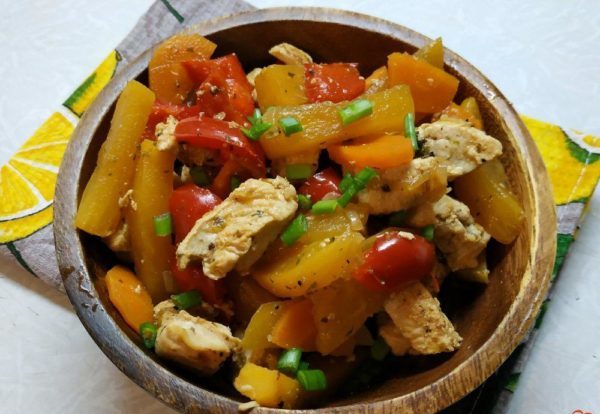
For this dish you will need:
- turnip - 300 g;
- beef - 450 g;
- champignons - 250 g;
- onions - 1 pc.;
- rosemary - several sprigs;
- tomato paste - 1 tbsp. l.;
- olive oil - 2 tbsp. l.;
- dry red wine - 120 ml;
- beef broth - 900 ml;
- carrots - 1 pc.;
- flour - 2 tbsp. l.;
- salt and black pepper - to taste.
Preparation:
- Mushrooms are cut into quarters, onions into small cubes, meat into large pieces. Heat the oil in a cauldron or saucepan and place the chopped food there.
- Add salt, pepper and chopped rosemary. Fry for 8-10 minutes until the meat is browned on all sides.
- Tomato paste and flour are added gradually, stirring the contents of the pan all the time. Pour in the wine and simmer for another 1 minute. Turnips and carrots are cut into large pieces and placed in the stew, pour in the broth.
- Bring the contents to a boil over high heat, then reduce the heat and cover the pan with a lid. Simmer for 30 minutes, stirring the stew occasionally. After half an hour, the broth will thicken a little, and the vegetables and beef will become soft.
Creamy puree with fruits
For preparation you will need:
- medium-sized turnip - 1 pc.;
- milk - 200 ml;
- butter - 10–20 g;
- apple - 1 pc.;
- dried apricots - 100 g.
The turnips are cleaned and cut into arbitrary pieces. Stew in milk for 30 minutes. Grind everything with butter until pureed.
While the turnips are stewing, the apple is cut into thin slices. The dried apricots are kept over hot steam for 10 minutes. To do this, use a colander and a pan of boiling water. Steamed dried fruits are cut into small cubes. Fruits are added to puree before serving.
How to choose and store turnips correctly
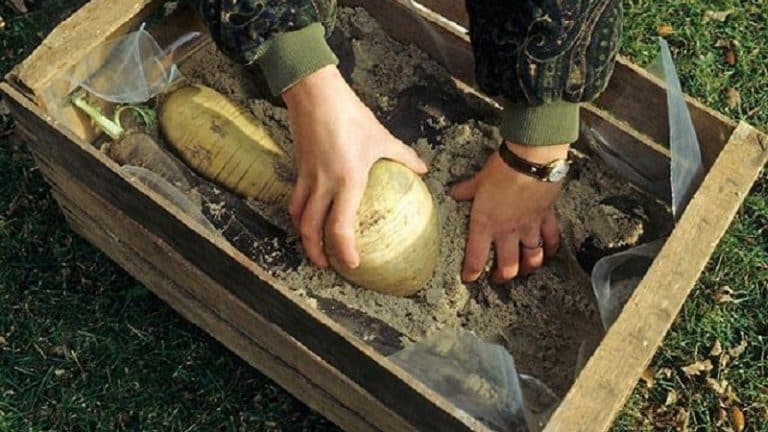
Turnips have many varieties that vary in flavor and color. Yellow root vegetables are juicier and have a stronger flavor. They have fairly coarse fibers. White vegetables do not have such a pronounced aroma, but they are much more tender, which is why they are better absorbed.
When choosing, pay attention to the skin. There should be no damage or stains on it. A ripe vegetable is always a little heavier than it seems at first glance.
Advice! It is better to buy a small turnip that will fit in the palm of your hand. Small vegetables are usually not bitter.
At the beginning of autumn or late summer, it is advisable to take turnips that have not had their tops cut off. It is by this that they determine how long ago the root crop was dug up.
When purchased in the fall, vegetables are stored in boxes with sand until spring. There is not enough ventilation in the refrigerator, so they last no longer than 2 months.
Vegetables purchased in winter or spring have most likely been in storage since last summer. This means that they were treated with preservatives and they lost most of the nutrients.
Reviews
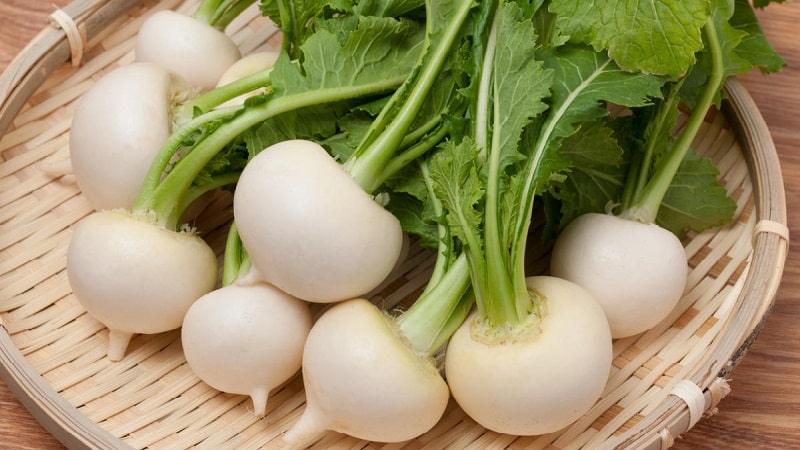
Reviews of turnips are mostly positive. Many people loved her:
Irina Ivanovna, Yekaterinburg: “I became acquainted with the vegetable completely spontaneously when I saw it in the store. The price was low - about 45 rubles. I used to think that the turnip was large, but it turned out to be small. The average diameter is 10 cm. I made puree from it, but I didn’t really like it. Then I decided to make a stew - turnips add a slight spiciness and a unique fresh taste to the dish. Now I regularly buy this vegetable, sometimes I eat it raw. I just grate it and add it to different salads.”
Maria Petrovna, Perm: “I often saw vegetables at the market; grandmothers sold them all the time. Although I've never seen it in stores. The root vegetable doesn't look very good, so I didn't even want to try it.I didn’t know how to cook turnips properly and what to eat them with. We recently moved to another country and have already become accustomed to some local dishes that would have been strange to me before. Turnips are sold here in any supermarket, and they are always available. Apparently people are willing to take it. One day I decided to make puree soup from it. Now my husband and I buy this vegetable regularly.”
Conclusion
Turnips are boiled, stewed, simmered, baked, added to various salads, and used as a side dish or main dish. Even the filling for dumplings and manti is made from the vegetable. This is a healthy and tasty product if you prepare it correctly and taking into account your preferences.